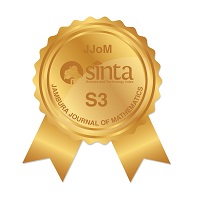Dinamika dan Stabilitas Populasi pada Model Penyebaran COVID-19 dengan Vaksinasi dan Migrasi Penduduk
Abstract
This article discusses the mathematical model of the spread of COVID-19 by considering vaccination and population migration. The former model is analyzed by determining the equilibrium point, basic reproduction number, analyzing the stability of the equilibrium point, sensitivity analysis, and accompanied by numerical simulation. Analysis of the stability of disease-free and endemic equilibrium points using the Routh-Hurwitz Criteria and the Castillo-Chaves and Song theorems. The results of the analysis show that there are two equilibrium points, namely a disease-free equilibrium point (T1), which is locally asymptotically stable when R0 < 1, and an endemic equilibrium point (T2), which is locally asymptotically stable when R0 > 1. Furthermore, the sensitivity analysis showed that the most sensitive parameters to changes in the basic reproduction number were the emigration rate parameter (m2) and the infection probability parameter after contact between infected and susceptible individuals without vaccination (h). In addition, the numerical simulation results show that the sensitive parameter values, namely m2, h, zse, g, and # have a significant effect on the basic reproduction numbers. Suppressing the chance of infection in susceptible individuals and the rate of contact between susceptible and exposed individuals, as well as increasing the number of individuals who emigrate and who are vaccinated, can reduce the transmission of COVID-19.
Keywords
Full Text:
PDFReferences
R. H. Pasaribu, Z. I. S. Harahap, B. A. Putra, and S. L. A. Siregar, "Aplikasi Pemodelan Matematika dalam Memodelkan Penyebaran Virus COVID-19 di Indonesia" in Semin. Nas. Mat. dan Pendidik. Mat, vol. 5, 2020, pp. 194-199.
WHO, "WHO Health Emergency Dashboard" 2021, [Online] Available at: https://covid19. who.int/region/searo/country/id/.
R. Resmawan and L. Yahya, "Sensitivity Analysis of Mathematical Model of Coronavirus Disease (COVID-19) Transmission" CAUCHY, vol. 6, no. 2, pp. 91-99, 2020, doi: 10.18860/ca.v6i2.9165.
S. Bugalia, V. P. Bajiya, J. P. Tripathi, M.-T. Li, and G.-Q. Sun, "Mathematical Modeling Of COVID-19 Transmission: The Roles Of Intervention Strategies And Lockdown" Math. Biosci. Eng, vol. 17, no. 5, pp. 5961-5986, 2020, doi: 10.3934/mbe.2020318.
S. Cakan, "Dynamic Analysis Of A Mathematical Model with Health Care Capacity for COVID-19 Pandemic" Chaos, Solitons and Fractals, vol. 139, 2020, doi: 10.1016/j.chaos.2020.110033.
R. Resmawan, A. R. Nuha, and L. Yahya, "Analisis Dinamik Model Transmisi COVID-19 dengan Melibatkan Intervensi Karantina" Jambura J. Math, vol. 3, no. 1, pp. 66-79, 2021, doi: 10.34312/jjom.v1i1.8699.
M. S. P. Pramudito, "Model SEIR Penyakit COVID-19 dengan Adanya Migrasi dan Pemberian Vaksin" MATH Unesa, vol. 09, no. 02, pp. 260-267, 2021.
L. A. Fauzia, "Analisis Pemodelan Matematika Penularan COVID-19 dengan Tindakan Rawat Inap di Rumah Sakit" MATH Unesa, vol. 09, no. 01, pp. 126-132, 2021.
Abdullah, S. Ahmad, S. Owyed, A.-H. Abdel-Aty, E. E. Mahmoud, K. Shah, and H. Alrabaiah, "Mathematical Analysis of COVID-19 Via New Mathematical Model" Chaos, Solitons and Fractals, vol. 143, p. 110585, 2021, doi: 10.1016/j.chaos.2020.110585.
K. Mu'tamar, S. Putra, and S. A. Perdana, "Analysis of the Spread of Covid-19 Using SIR Models and Vaccination with Parameter Estimations" Barekeng, vol. 15, no. 2, pp. 323-334, 2021, doi: 10.30598/barekengvol15iss2pp323-334.
S. Utina, I. Djakaria, I. K. Hasan, R. Resmawan, A. R. Nuha, and S. K. Nasib, "Model stokastik tipe sirv pada penyebaran covid-19 dengan mempertimbangkan efektivitas vaksinasi" JFOURIER, vol. 11, no. 1, pp. 7-16, 2022, doi: 10.14421/fourier.2022.111.7-16.
R. Resmawan, L. Yahya, R. S. Pakaya, H. S. Panigoro, and A. R. Nuha, "Analisis dinamik model penyebaran covid-19 dengan vaksinasi" Jambura Journal of Biomathematics (JJBM), vol. 3, no. 1, pp. 29-38, 2022, doi: 10.34312/jjbm.v3i1.13176.
S. Javeed, S. Anjum, K. Saleem, M. Atif, M. Shaukat, W. A. Farooq, A. Hanif, H. Ahmad, and S.-w. Yao, "A Novel Mathematical Model for COVID-19 with Remedial Strategies" Results in Physics, vol. 27, p. 104248, 2021, doi: 10.1016/j.rinp.2021.104248.
A. A. Sitinjak, "Penentuan Rumus Bilangan Reproduksi Dasar pada Model Matematika COVID-19 dari Model SIR yang Dimodifikasi" Edumatsains, vol. 2, no. 2, pp. 203-210, 2021, doi: 10.33541/edumatsains.v5i2.2222.
Z. Armandani and Y. Fuad, "Penerapan Model SEQIR dengan Kontrol Optimal pada Sistem Dinamik Pandemi COVID-19" J. Ilm. Mat. MATH Unesa, vol. 9, no. 2, pp. 366-379, 2021, doi: 10.26740/mathunesa.v9n2.p366-379.
M. Manaqib, I. Fauziah, and E. Hartati, "Model matematika penyebaran COVID-19 dengan penggunaan masker kesehatan dan karantina" Jambura J. Biomath, vol. 2, no. 2, pp. 68-79, 2021, doi: 10.34312/jjbm.v2i2.10483.
A. R. Nuha, N. Achmad, and N. Supu, "Analisis Model Matematika Penyebaran COVID-19 dengan Intervensi Vaksinasi dan Pengobatan" Jurnal Matematika UNAND, vol. 10, no. 3, pp. 406-422, 2021.
A. J. Kucharski, T. W. Russell, C. Diamond, Y. Liu, J. Edmunds, S. Funk, and R. M. Eggo, "Early Dynamics of Transmission And Control of COVID-19: A Mathematical Modelling Study" Lancet Infect Dis, vol. 20, pp. 553-558, 2020, doi: 10.1016/S1473-3099(20)30144-4.
S. E. Ramdhani, "Model Matematika Penyebaran COVID-19 dengan Pengaruh Pengobatan" J. Ilm. Mat. MATH Unesa, vol. 9, no. 1, 2021.
P. V. D. Driessche and J. Wathmough, "Reproduction issues and sub-threshold endemic equilibria for compartmental models of disease transmission" Mathematical Biosciences, vol. 180, no. 1-2, pp. 29-48, 2002, doi: 10.1016/S0025-5564(02)00108-6.
C. Castillo-Chavez and B. Song, "Dynamical Models of Tuberculosis and Their Applications Carlos Castillo-Chavez" Math. Biosci. Eng, vol. 1, no. 2, pp. 361-404, 2004.
M. Azizah, "Model Matematika Penyebaran Penyakit Coronavirus Disease 2019 (COVID-19) dengan Vaksinasi, Isolasi Mandiri, dan Karantina di Rumah Sakit" Ph.D. dissertation, Universitas Negeri Syarif Hidayatullah, 2021.
N. Chitnis, J. M. Hyman, and J. M. Cushing, "Determining Important Parameters in the Spread of Malaria Through the Sensitivity Analysis of a Mathematical Model" Bull. Math. Biol, vol. 70, pp. 1272-1296, 2008, doi: 10.1007/s11538-008-9299-0.
DOI: https://doi.org/10.34312/jjom.v5i2.19992
Copyright (c) 2023 Resmawan, Lailany Yahya, Agusyarif Rezka Nuha, Sri Meylanti S. Ali

This work is licensed under a Creative Commons Attribution-NonCommercial 4.0 International License.
Jambura Journal of Mathematics has been indexed by
Jambura Journal of Mathematics (e-ISSN: 2656-1344) by Department of Mathematics Universitas Negeri Gorontalo is licensed under a Creative Commons Attribution-NonCommercial 4.0 International License. Powered by Public Knowledge Project OJS.
Editorial Office
Department of Mathematics, Faculty of Mathematics and Natural Science, Universitas Negeri Gorontalo
Jl. Prof. Dr. Ing. B. J. Habibie, Moutong, Tilongkabila, Kabupaten Bone Bolango, Gorontalo, Indonesia
Email: [email protected].




















